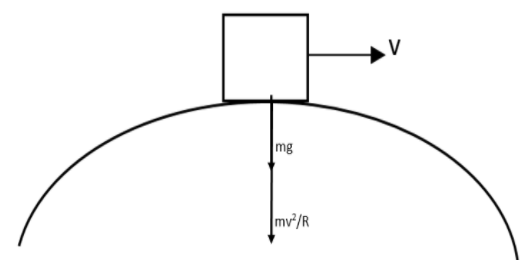
Let us assume that a national roadway bridge over a canal will be in the form of an arc of a circle of radius $49m$. Without leaving the ground at the highest point, find out the maximum speed with which a vehicle can move? (Take,$g=9.8m{{s}^{-2}}$)
$\begin{align}
& A.19.6m{{s}^{-1}} \\
& B.40m{{s}^{-1}} \\
& C.22m{{s}^{-1}} \\
& D.\text{none of these} \\
\end{align}$
Answer
559.5k+ views
Hint: The maximum velocity with which a vehicle can move without leaving the ground at the highest point can be found by taking the square root of the product of the acceleration due to gravity and the radius of the circular path taken. Substitute the values in the equation. This will help you in answering this question.
Complete answer:

The centripetal force will be equivalent to the gravitational force on the body. That is,
$m\dfrac{{{v}^{2}}_{\max }}{R}=mg$
The maximum velocity with which a vehicle can move without leaving the ground at the highest point can be found by taking the square root of the product of the acceleration due to gravity and the radius of the circular path taken. This can be written as an equation given as,
${{v}_{\max }}=\sqrt{gR}$
It has been already mentioned in the question that the radius of the circular path taken by the vehicle be,
$R=49m$
The acceleration due to gravity has been mentioned as,
$g=9.8m{{s}^{-2}}$
Now let us substitute the values in the equation which can be shown as,
${{v}_{\max }}=\sqrt{9.8\times 49}=22m{{s}^{-1}}$
Therefore the maximum velocity with which a vehicle can move without leaving the ground at the highest point has been calculated.
The correct answer has been mentioned as option C.
Note:
The maximum safe speed is defined as the maximum possible speed a vehicle can move when they are traversing through a circular path. This speed is dependent upon the acceleration due to gravity, angle of inclination with the horizontal and radius of curvature. The maximum safe speed will not be dependent on the mass of the vehicle travelling.
Complete answer:

The centripetal force will be equivalent to the gravitational force on the body. That is,
$m\dfrac{{{v}^{2}}_{\max }}{R}=mg$
The maximum velocity with which a vehicle can move without leaving the ground at the highest point can be found by taking the square root of the product of the acceleration due to gravity and the radius of the circular path taken. This can be written as an equation given as,
${{v}_{\max }}=\sqrt{gR}$
It has been already mentioned in the question that the radius of the circular path taken by the vehicle be,
$R=49m$
The acceleration due to gravity has been mentioned as,
$g=9.8m{{s}^{-2}}$
Now let us substitute the values in the equation which can be shown as,
${{v}_{\max }}=\sqrt{9.8\times 49}=22m{{s}^{-1}}$
Therefore the maximum velocity with which a vehicle can move without leaving the ground at the highest point has been calculated.
The correct answer has been mentioned as option C.
Note:
The maximum safe speed is defined as the maximum possible speed a vehicle can move when they are traversing through a circular path. This speed is dependent upon the acceleration due to gravity, angle of inclination with the horizontal and radius of curvature. The maximum safe speed will not be dependent on the mass of the vehicle travelling.
Recently Updated Pages
Master Class 11 Economics: Engaging Questions & Answers for Success

Master Class 11 English: Engaging Questions & Answers for Success

Master Class 11 Social Science: Engaging Questions & Answers for Success

Master Class 11 Biology: Engaging Questions & Answers for Success

Class 11 Question and Answer - Your Ultimate Solutions Guide

Master Class 11 Business Studies: Engaging Questions & Answers for Success

Trending doubts
10 examples of friction in our daily life

One Metric ton is equal to kg A 10000 B 1000 C 100 class 11 physics CBSE

Difference Between Prokaryotic Cells and Eukaryotic Cells

1 Quintal is equal to a 110 kg b 10 kg c 100kg d 1000 class 11 physics CBSE

State the laws of reflection of light

Explain zero factorial class 11 maths CBSE




